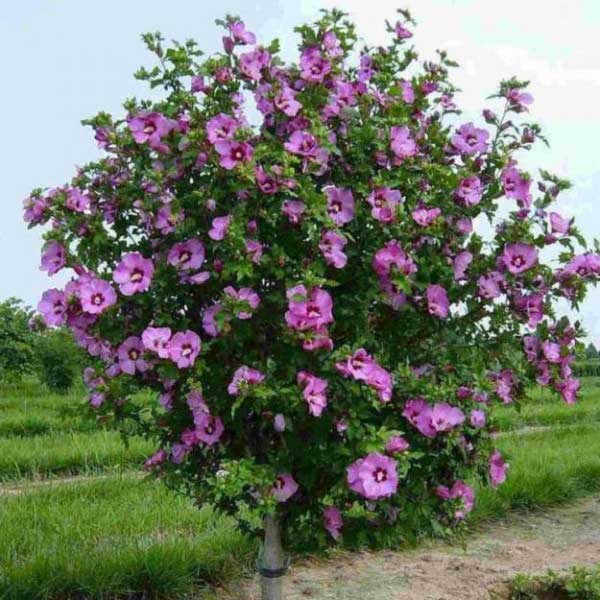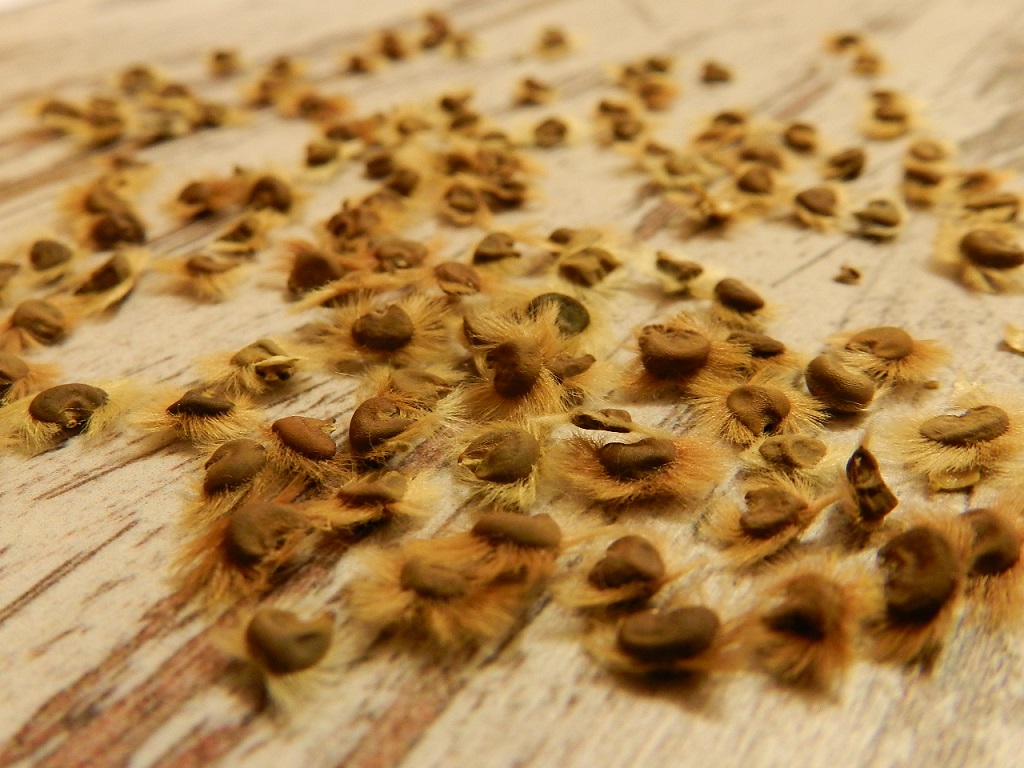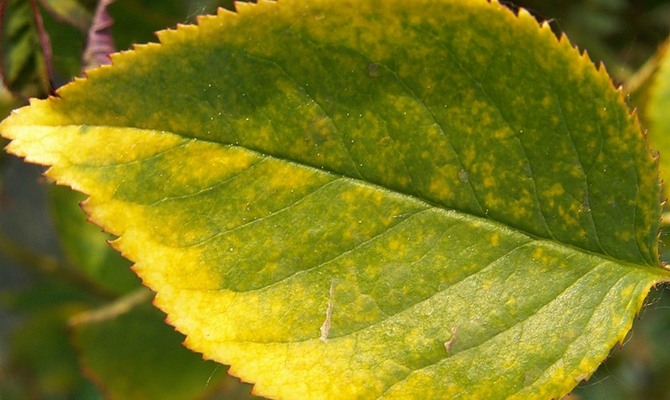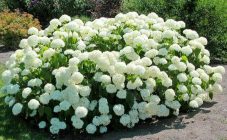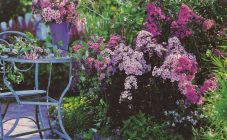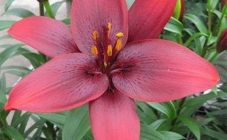Content:
This warm-loving exotic flower arrived in Russia from distant and warm Southeast Asia and the Middle East. How to grow it and what care does Syrian hibiscus require - below in the article.
General information about the flower
In nature, there are about 300 species of this perennial representative of the Malvov family, however, in Russian latitudes with a short summer period and severe frosts (up to −20 ° C), only Syrian hibiscus has taken root and reproduces perfectly, both in the open field and in apartments and offices.
In its natural habitat at home, it reaches 6 m in height and blooms throughout the warm season.
Thanks to a whole list of unique features, it is extremely difficult not to recognize and confuse it with other representatives of the plant world:
- bright green ovoid foliage;
- large single white, pink, lilac flowers, simple or double. The diameter of the largest in blooming can reach 20-25 cm.
Looks good as a separate element of landscape design, surrounded by rose bushes or elegant lavender, the smell of which scares off aphids and other harmful small insects, and as a hedge.
Distinctive features and varieties
In central Russia, the most widespread is the Syrian rose - hibiscus, which is distinguished by winter hardiness and ease of cultivation. This unpretentious flower loves warmth, light, but is afraid of excessive moisture and drafts.
The flowering period is late July-early September. A large number of flower buds are formed. And, despite the fact that the life of the bud is one day, wilting is not noticeable, and the appearance of the plant does not deteriorate.
In the gardens of the Urals and central Russia, the deciduous shrub grows up to 1.5-2 m in height. The flowers reach 7-12 cm in diameter and can be monochromatic and two-colored.
The most popular types:
- Hybrid (garden, herbaceous). Received in the middle of the 20th century. Winter-hardy, straight-stemmed. From the ground to the top it reaches 1-1.7 m. The buds 12 cm in diameter are bright pink. The foliage is emerald-amber. May be annual.
- Youth. Weakly branched bush up to 1.5 m high. Differs in yellow-malachite color of shoots growing at an angle of 60 °, and snow-white flowers 10 cm in diameter, having the shape of a tulip.
- Late. Compact shrub measuring 1 × 1 m. Leaves with whitish veins and serrated tips adhere tightly to each other. Among others, they stand out with an oval arrow-shaped shape, low pedicels and narrow inflorescences-bells of raspberry-pinkish and lilac tones with a volume of 7 cm.
- Pale pink... Height 170 cm. Shoots are small, located at an angle of 60 °. Serrated yellow-green cut foliage. Buds 12 cm in circumference in the form of a tulip with a white bottom and pink "walls".
- Pink-porcelain reaches a height of 130 cm.The bush has amber-green branched long stems and deeply incised leaves (6 cm), as well as, bell-like, pale pink rosettes with barely visible yellowness and a boiling white throat with a diameter of 12 cm. The inflorescences are united in a brush on a low peduncle.
- Indoor, or Chinese rose... Bred for greenhouses, gardens, rock garden and rose garden. Breeding in a home microclimate and greenhouses will also be optimal. Blooms all year round.
- Swamp. These are large flowers 12 cm in diameter. Looks great as a hedge.
- Sour... Another name for annual maple. The bush is characterized by wedge-shaped carved leaves and red petals. It harmoniously fits into landscape design as an independent element, and is also used to build a living fence.
Planting and caring for Syrian hibiscus outdoors
The shrub is extremely unpretentious. It's easy to look after him. There are several main points, if observed, even in the zone of risky farming, he will feel at home:
- Choosing a place on the site. It should be a bright place protected from drafts and direct sunlight.
- Regular watering with soft (rain or settled tap) water.
- Timely seasonal fertilization.
- Light, loose soil with a drainage base.
- Periodic loosening and weeding.
- Correct reproduction of an existing bush or the acquisition of a healthy, strong sprout.
The Syrian rose can be propagated in the following ways:
Seed (January to March)
The seeds are immersed in a dark pink solution of potassium permanganate for half an hour in advance, and then in an epin solution for a day so that they are barely covered. Planting furrows are prepared in advance, no more than 1 cm deep, into which the processed planting material is introduced. Then it is covered with soil and watered with soft water. The outdoor greenhouse is kept closed. Open only for timely moderate watering and ventilation.
Further care for seedlings is simple: loosening row spacings, moistening the soil, timely feeding, processing from aphids and thinning (if necessary).
The box with seedlings is covered with plastic wrap until the first shoots appear. Landing in open ground is carried out in early March or the second half of May - the first decade of July, respectively.
Cuttings
Reproduction in this way is possible in two ways:
- The material is harvested from mid-June to July 10 inclusive. The length of the cuttings should be 12 - 15 cm. Green sprouts are rooted in a mixture of peat and sand (1: 1) to a depth of 3 cm in a greenhouse at a temperature of 20 - 25 ° C and an air humidity of 80 - 85%. For the formation of a more powerful root system before planting, it is recommended to treat with a stimulant ribav extra (soaking in the solution for about 10 - 15 minutes).
- Taking green twigs with 5 - 7 buds should take place in the second half of September. Treatment with a stimulant before planting in a soil substrate (similar to the composition in the first case) is not needed. A feature of the method is the use of an "artificial fog" installation. At the same time, a humidity of 90 - 95% is maintained and a temperature difference of 30 - 35 ° С during the day and 24 - 26 ° С is created. In this microclimate, the roots appear on the 17th day. After that, the humidity is reduced to 80%
With any grafting method, after a month the seedlings are ready for transshipment.
These are the main breeding methods. In addition to them, layering and grafting are used.Hybrids are propagated by dividing the rhizomes in early spring after cutting off the shoots and before flowering. New bushes are watered after being placed in a permanent place, providing proper care. And after a year they will bloom.
Planting instructions:
- Immediately before transshipment, the cutting is not watered. The earth lump must be dry.
- Preparation of the landing pit. It should be 2 times the rhizome of the plant. Drainage is laid at the bottom (for example, broken brick), the layer height is at least 15 cm. Then, alternately, sand and compost are added in equal shares.
- The seedling is moved very carefully into the hole, sprinkled with a substrate consisting of turf, peat and sand (1: 1: 1), without deeply deepening the root collar. The young plant is hilled, making a furrow around the circumference, which is well moistened.
- The hole is filled with soil and leveled.
Features of the successful growth of a flower in the Moscow region:
- For planting, choose varieties with ordinary inflorescences. Such a shrub can withstand short frosts down to -20 ° C.
- It is necessary to provide a warm wintering. In addition to preparation (pruning and pulling branches to the trunk), mulching, spruce branches in 3 rows and films, it is worth building a protective structure over the “southerner”. You can also dig up the plant, move the container and send it to a warm room for the winter.
- It is recommended to provide protection against small rodents during the cold season.
- The first young shoots appear in late spring, when the air temperature does not drop below 12-15 ° C. For the region indicated above, this is the end of May.
- The buds begin to bloom in early August and continue until mid-September.
- By the end of the first month of autumn, the bush gradually turns yellow and prepares for rest.
Plant care rules
Due to its unpretentiousness, caring for the bush is not difficult even for novice florists. Here is a list of the work required for the successful growth and development of hibiscus:
- Abundant timely watering. If the summer is dry and the weather is very hot, then it is spent every day. In the spring, in autumn in cool weather, immediately after planting, moistening is carried out only after the soil around the garden hibiscus is completely dry.
- Loosening - a mandatory procedure, as it saturates the soil with oxygen, makes it easier.
- Mulching - seasonal work. In the hot season, it retains moisture and protects against weeds. During cold weather it gives warmth, helping to winter safely. The bark of trees, sawdust, dry peat are used as material.
- Pruning... It is carried out in order to remove wilted buds, thereby prolonging the flowering period, and freeing the plant from old damaged branches, as well as from a certain amount of growth of the last year (by about 2/3) to stimulate the vegetation process.
- Top dressing... During the flowering period, it is carried out 2 times a month with either of the two options. An alternative method is to apply fertilizers in liquid form at the root. To do this, use a 20-day infusion of dry compost or a solution of chicken manure that has been fermented for 14 days. In the middle - end of September, for a safe wintering, they are fed with potash fertilizers. So the plant gets the nitrogen and phosphorus it needs.
Disease and pest control
The main enemies of the Syrian rose, especially in hot weather, are spider mites, whiteflies, aphids and thrips. To get rid of them, insecticides are used: actellik, fitoverm, karbofos, intavir. Number of treatments - 2 times, interval 7 - 10 days.
The most common diseases:
- Chlorosis... Signs are wilting and falling of the lower leaves, the appearance of new foliage with a yellow tint. The reason is the lack of iron and nitrogen in the soil. Treatment - watering with water containing iron chelate. Prevention - feeding in the spring with a complex nitrogen-containing fertilizer.
- The green mass turns noticeably yellow... In addition to chlorosis, the reason may be insufficient watering during drought, as well as damage to the root system during transshipment. This is treated by adding zircon or root to the irrigation water and spraying the foliage with aqueous solutions of the above drugs (3 drops per half liter of water).
- Tree plantation does not bloom... This may indicate a lack of phosphorus and boron. Treatment is the application of appropriate mineral fertilizers.
Use in landscape design
Due to the variety of shapes and colors, the Syrian hibiscus is widely used:
- Used to form arched openings and hedges. Optimal beauty will be visible after 5 years.
- Hybrid species are ideal for creating large flower arrangements, decorating ponds, and decorating borders. Non-flowering shrubs complement well.
- A tall herbaceous representative of this family well covers the design flaws. Also used as a separate element of garden decor.
The above description of hibiscus will become a cheat sheet for a novice florist on growing and caring for a plant. If everything is done correctly, then abundant flowering will not take long. And most importantly, remember that any chosen flower needs attention, love and care.
